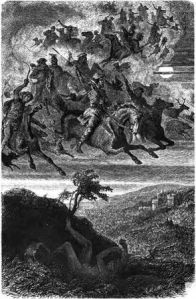For a few years in the middle of the eighteenth century, this fellside on the eastern edge of Blencathra was the the site of spectacular scenes.
The first sighting was on Midsummer’s Eve in 1735. A servant of Mr Lancaster watched a procession of ‘soldiers’, some on foot, some mounted, progress across the fell. He reported his sighting, but was widely abused. Two years later, Mr Lancaster himself, with other members of his family, witnessed the sight; on this occasion, they noted that the procession was five men deep, with mounted ‘officers’ riding around to keep them in order. No one believed Mr Lancaster’s report, either.
On Midsummer’s Eve in 1745, no less than 26 people observed the ghostly procession. This time it included carriages, which could not possibly have managed the steep incline. The line of men, horses and carriages was half a mile long, and took several hours to traverse the fell. The 26 witnesses swore their account to a magistrate because this was the time of the second Jacobite rebellion and Cumberland had every reason to worry about large gatherings of men hereabouts. After this, some other people came forward and said that they had seen the same gathering two years earlier, in 1743.
These accounts were recorded in detail in The Gentleman’s Magazine in 1747 and by Harriet Martineau in 1855.
On all these occasions, witnesses went up the fell the following day to look for hoof prints, to no avail. All witnesses agreed that the people looked ‘solid’ rather than vaporous and overtly ‘ghostly’ and yet the unlikeliness of the procession – especially those carriages – convinced them that it was surely supernatural. I can find no specific description of the processors’ clothing to explain why observers thought they were soldiers. Perhaps they extrapolated this from the formation of the line of walkers, kept in line by horseriders.
Commentators have been swift to link the ghostly procession with the Jacobite rebellion, suggesting that the apparition was a projection of troop movements over the border – even though that border is about thirty miles away. These people presumably discount the reports that pre-date the Jacobites.
There is another account of an other-worldly procession1, dated to the autumn of 1513. A man called Simon Bell, travelling between Ambleside and Kendal, witnessed a long procession with a military air. Whilst there were military movements in Scotland at the time (this being a month after Flodden), there were, supposedly, no troops in the area at the time. Simon died later that night.
Folklorists will have spotted that these accounts are reminiscent of processions recorded through the ages across northern Europe, variously attributed to Herne the Hunter, King Herla, the ‘Wild Hunt’, Gwynn ap Nudd, the ‘Faery Raed’ and other sidhe-related events (and indeed, Simon Bell was passing ‘Elf Howe’ when he sighted his procession).
To my knowledge, there have been no further sightings of the procession on Souther Fell.
1. Legends of Westmorland and the Lake District, Anon (1868)
Note: In 1967 Gerald Findler wrote a book called Legends of the Lake Counties in which he stated that Daniel Strickland (actually Stricket) had sighted the procession again in 1785. This is incorrect. Findler had misread a witness account procured by James Clarke in 1785 (recorded in his A Survey of the Lakes (1787)), which unequivocably referred to events of 1743 and ’44. Findler himself implicitly acknowledged his error by not repeating it in his 1975 book, Ghosts of the Lake Counties.
Further reading: a new book by the name of The Spectral Army of Souther Fell by Stephen Matthews (2011), Bookcase, Carlisle.

A fascinating tale, and one I have no doubt will be true.
Best wishes, CJ xx
Hi CJ! It does seem to be well-witnessed, doesn’t it? But still downright peculiar.
Pingback: Corpse roads, faerie and ghostly goings-on | Esmeralda's Cumbrian History & Folklore
Pingback: The Claife Crier, Windermere’s famous spook | Esmeralda's Cumbrian History & Folklore
Pingback: The elven procession at Staveley | Esmeralda's Cumbrian History & Folklore
Pingback: Eveling: Cumbria’s Faerie King, or Celtic God? | Esmeralda's Cumbrian History & Folklore
Pingback: Armboth: Cumbria’s Most Haunted | Esmeralda's Cumbrian History & Folklore
Pingback: Eveling, Cumbria’s faery king and Celtic god | Esmeralda's Cumbrian History & Folklore
Pingback: The Cumbrian Halloween round-up! | Esmeralda's Cumbrian History & Folklore
Pingback: Dobbies, boggles, ghosts and the 19th century journalist… | Esmeralda's Cumbrian History & Folklore
Pingback: Souther Fell: in the footsteps of the spectral army « terrasubarctica
Pingback: Rain and wind in the lakes | PeakToPub